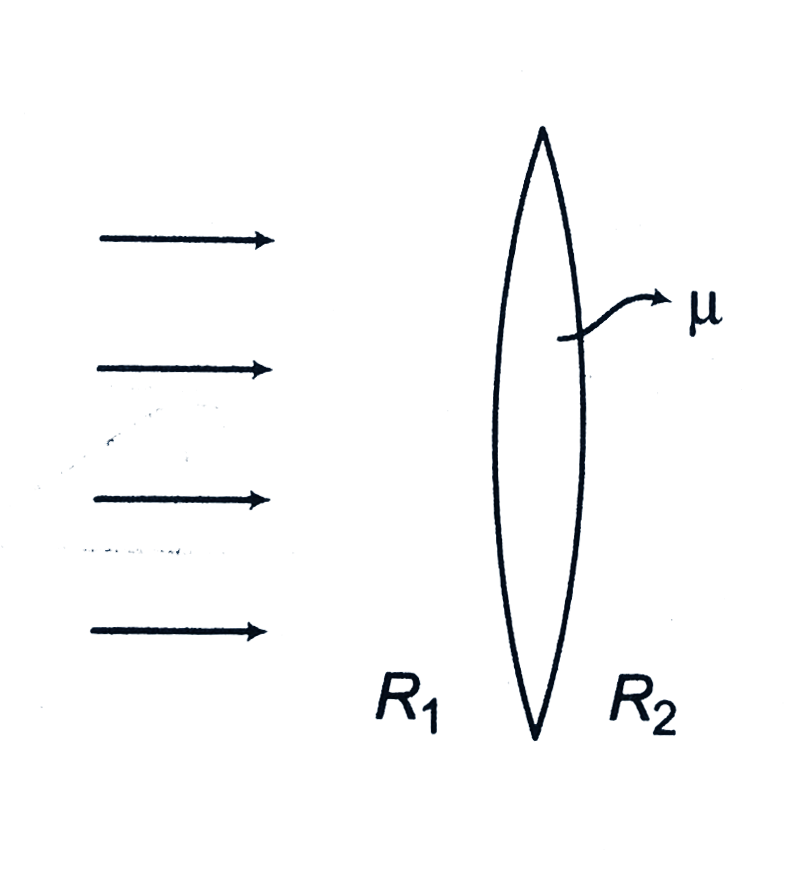A biconvex lens of radii of curvature 20 cm has refractive index 1.56 for blue colour and 1.48 for red colour. The approximate linear spread of focus for white light is
3.6 cm
4.2 cm
3.0 cm
5.0 cm
The correct Answer is:C
To solve the problem of finding the approximate linear spread of focus for white light using a biconvex lens, we will follow these steps:
Step 1: Understand the Lens Formula
The lens formula for a biconvex lens is given by:
1f=(μ−1)(1R1−1R2)
For a biconvex lens, both radii of curvature (R1 and R2) are equal in magnitude but opposite in sign. Thus, if we denote the radius of curvature as R:
- R1=+R
- R2=−R
Step 2: Substitute Values into the Lens Formula
Substituting the values into the lens formula:
1f=(μ−1)(1R−1−R)=(μ−1)(1R+1R)=(μ−1)(2R)
Thus, we can express the focal length f as:
f=R2(μ−1)
Step 3: Calculate Focal Length for Blue and Red Light
Given:
- R=20cm
- μblue=1.56
- μred=1.48
Now, calculate the focal lengths for blue and red light:
1. For blue light:
fblue=202(1.56−1)=202(0.56)=201.12≈17.86cm
2. For red light:
fred=202(1.48−1)=202(0.48)=200.96≈20.83cm
Step 4: Calculate the Difference in Focal Lengths
Next, we find the difference in focal lengths:
Δf=fred−fblue≈20.83−17.86≈2.97cm≈3cm
Step 5: Conclusion
The approximate linear spread of focus for white light is:
Δf≈3cm
The lens formula for a biconvex lens is given by:
1f=(μ−1)(1R1−1R2)
For a biconvex lens, both radii of curvature (R1 and R2) are equal in magnitude but opposite in sign. Thus, if we denote the radius of curvature as R:
- R1=+R
- R2=−R
Substituting the values into the lens formula:
1f=(μ−1)(1R−1−R)=(μ−1)(1R+1R)=(μ−1)(2R)
Thus, we can express the focal length f as:
f=R2(μ−1)
Given:
- R=20cm
- μblue=1.56
- μred=1.48
1. For blue light:
fblue=202(1.56−1)=202(0.56)=201.12≈17.86cm
fred=202(1.48−1)=202(0.48)=200.96≈20.83cm
Next, we find the difference in focal lengths:
Δf=fred−fblue≈20.83−17.86≈2.97cm≈3cm
The approximate linear spread of focus for white light is:
Δf≈3cm
Topper's Solved these Questions
- OPTICSBook:FIITJEEChapter:OPTICSExercise:Comprehension-1(prob)
Explore 3 Videos
- OPTICSBook:FIITJEEChapter:OPTICSExercise:Comprehension-2(prob)
Explore 3 Videos
- OPTICSBook:FIITJEEChapter:OPTICSExercise:SOLVED PROBLEMS (SUBJECTIVE)
Explore 18 Videos
- MODERN PHYSICSBook:FIITJEEChapter:MODERN PHYSICSExercise:Numerical based questions
Explore 5 Videos
- PHYSICS PART-IIIBook:FIITJEEChapter:PHYSICS PART-IIIExercise:NUMERICAL BASED QUESTIONS DECIMAL TYPE
Explore 11 Videos
Similar Questions
Knowledge Check
A biconvex lens with equal radii curvature has refractive index 1.6 and focal length 10 cm. Its radius of curvature will be:
A20 cmB16 cmC10 cmD12 cmThe power in dioptre of an equi-convex lens with radii of curvature of 10cm and refractive index 1.6 is
A+12B+18C+1.2D+1.8A double convex lens has faces of radii of curvature 30 cm each. The refractive index of the material of the lens is 1.5. What is the focal length of this lens when immersed is carbondisulphide of refractive index 1.6 ?
A−120cmB−180cmC−200cmD−240cm
A bicovex lens has radii of cuvature 20 cm each. If the refractive index of the material of the lens is 1.5, what is its focal length?
View SolutionA biconvex lens has radii of curvature 20 cm and 40cm. The refractive index of the material of the lens is 1.5. An object is placed 40cm in front of the lens. Calculate the psition of the image.
View SolutionA biconvex lens has equal radii of curvature of 20 cm for each face and is made of material of refractive index 1.5. An object of 6 cm height is placed at a distance of 10 cm from the lens. Find the position, nature and size of the image.
View SolutionThe focal length of a biconvex lens is 20 cm and its refractive index is 1.5. If the radii of curvatures of two surfaces of lens are in the ratio 1:2, then the larger radius of curvature is (in cm)
View SolutionFocal length of a lens is 0.12 m and refractive index is 1.5. Focal length of the same lens for blue colour is 0.1m. Theh refractive index of the lens for blue colour is
View Solution

